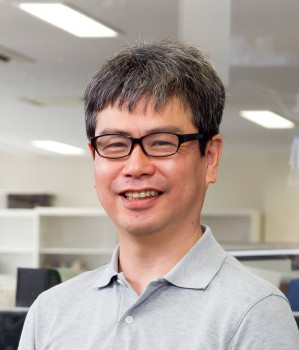Cultivating Leaders to Generate Innovations through the Integration of Information, Life, and Cognitive/Brain Sciences
Hiroshi Shimizu, Program Coordinator
 The Humanware Innovation Program (HWIP) is one of Osaka University’s Leading Programs in Doctoral Education, dedicated to the task of cultivating doctoral professionals. In this program, students develop the capacity to play leadership roles in tackling a variety of complex, multifaceted challenges that cannot be addressed through the pursuit of research in any one discipline.
The Humanware Innovation Program (HWIP) is one of Osaka University’s Leading Programs in Doctoral Education, dedicated to the task of cultivating doctoral professionals. In this program, students develop the capacity to play leadership roles in tackling a variety of complex, multifaceted challenges that cannot be addressed through the pursuit of research in any one discipline.
Why integrate information, life, and cognitive/brain science?
Our original aim when designing the Humanware Innovation Program (HWIP) was to integrate approaches from the information and life sciences. This is because we saw potential to develop information systems equipped with the flexibility seen in organic functions, and sustainable energy systems inspired by the energy-saving properties of organisms.
However, it is not possible to generate innovations simply using science and technology. Substantial social impact can only be achieved if users are satisfied with what is produced and feel comfortable with the information environment created. In recent years, brain and cognitive science research has emerged as a more objective means of assessing the response of users than simply conducting interviews and surveys. It is for this reason that we decided it was important to add the field of cognitive/brain science to our original combination of information and life sciences, creating a three-way approach.
HWIP seeks to produce “networking” doctoral professionals equipped with expertise across these three fields and capable of generating innovations that mutually incorporate each of them. “Networking” doctoral professionals are people who continue to delve deeply into their own field of specialization at the same time as acquiring expertise from other fields and applying it to their own, and vice versa.
What does HWIP offer students?
What kind of support does HWIP offer to enable its students to make the most of their capabilities globally? In essence, it cultivates students as truly elite doctoral professionals, capable of producing innovations and exercising leadership across the world.
Three key features of the program
1) Seido Jukugi: Intensive interdisciplinary studies
HWIP aims to equip its students with a capacity to engage with researchers and other students not only within their own field but in other fields of research. At the same time as developing their own disciplinary foothold, students are encouraged to pursue intensive dialogue with other researchers in an approach known as Seido Jukugi in Japanese. Seido means to stand at the boundary between self and other; Jukugi means to engage in careful deliberation and discussion. This approach is reflected in many features of the program, including intensive retreats and joint research projects.
2) Collaborative networks with industry and academia
What is the social value of university research? What kinds of research and researcher attributes does society need? Through hands-on experience at companies and external research institutes, students have opportunities to experience the challenges of work beyond graduate school and the importance of communication. At the same time, we hope that they will return not only with enhanced research skills, but also a stronger sense of what it is like to work in the wider world.
Fostering innovation leaders to stand at the forefront of organizations across many areas of society: that is the aim of the Humanware Innovation Program, and the ambition of all of us involved in it.
3) Respect for student independence
HWIP provides extensive backing for self-motivated student activities. We actively support students taking the initiative to invite external guests to deliver lectures, engage in outreach activities beyond the university, and undertake a variety of other activities. We hope that by planning, operating, and reporting on such projects themselves, students will develop their capabilities in design, management, and communication.
